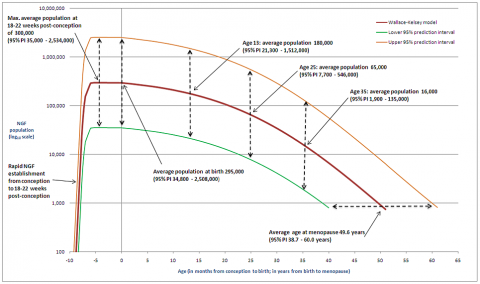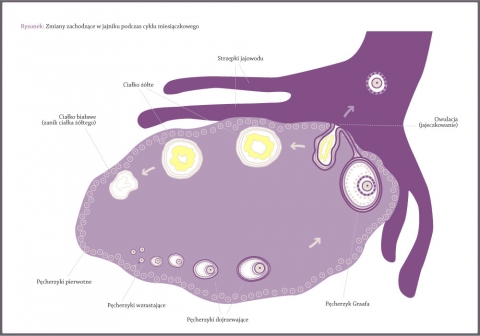Fertility is the ability to conceive a new human being – it is the life transfer by joining male and female reproductive cells.
The male fertility, the ability to produce male gametes – sperms, is constant since the end of puberty until death. The female fertility, including the ability to produce female gametes - eggs, is periodic, cyclical and disappears about the age of 55. It means that the fertility of couples, men and women, is also periodic, determined by the rhythm of the woman’s fertility.
Awareness of the sperm production mechanism in the male body and the changes in a woman’s body related to the her cycle of fertility is the basic knowledge and each mature, fertile person should know it.
In the following sections of this article some basic issues regarding the fertility of men and women will be discussed:
- The woman’s fertility results from an ovarian (ovulation) reserve possessed by her from birth and cyclical processes that enable to produce a mature egg and to ensure the proper conditions inside the woman’s body for conception and development of a new life are activated and they last until menopause;
- Semen production (spermatogenesis) with a sufficient amount of mature sperms takes about 2.5 months and during this time a number of factors can affect its quality and eventually it can cause problems with fertility;
- Fertility of the couple is not accidental but it results directly from the woman’s fertility cycle and the ability to recognize the signals sent by woman’s body allows for non-invasive, natural family planning;
- Fertility of the couple depends on three factors simultaneously: a good quality of an egg, sperm quality and good quality of cervical mucus.
The female fertility
Woman’s fertility consists a number of complex cyclical processes leading to periodic production of a mature egg and preparing the environment for its fertilization, development and maintenance as a new human being.
The female reproductive cell - the egg - is released regularly in the mature woman’s ovaries from adolescence to menopause (about the age of 55). It is worth remembering that every woman at the moment of birth has the ovarian reserve - a number of primary follicles with immature eggs. According to a recent study [1], conducted by Dr Hamish Wallace and Dr Tom Kelsey, at the moment of birth, this reserve amounts to about 300 thousand follicles and steadily decreasing with age to less than one thousand before the menopause. During these studies the researchers observed the great diversity of the ovarian reserve size. In the cases of some women this amount was about 2,000,000 capable of growing follicles, while for others the figure was only about 35 thousand. According to the model defined during the study, shown in the graph below, the ovarian reserve of the woman aged 30 accounts for only 12% on average of her reserve from the moment of her birth.
Reduced ovarian reserve in the reproductive age can cause problems with fertility, and its determination is very important in the diagnosis of infertility.
During the life of the woman only about 400 eggs from her ovarian reserve become mature. The moment of reaching sexual maturity is the starting point of the cyclical follicular growth process which lasts until the menopause. In this process the consecutive groups of primary follicles containing oocytes become the developing follicles; in each cycle one of them (and sometimes more than one) becomes dominant, then it turns into a Graafian follicle which releases the egg into the fallopian tubes (ovulation). The process of preparing a particular egg begins about three months before its release. From 50 to 300 primary follicles begins to grow, but only one (in some cases more than one) becomes dominant after 10 weeks. The egg in this follicle matures and it is released during an ovulation. A stimulation of the primary follicles growth takes place in each menstrual cycle, but the entire process of follicular growth from the signal sent by the brain to the ovulation takes several menstrual cycles, which means that at any time the ovary contains follicles in all stages of development.
The egg released during an ovulation lives up to 12 hours (or 24 hours in the case of a multiple ovulation).
The whole process of follicular growth and eggs release is associated with a woman’s hormonal cycle, which also stimulates the creation of the conducive environment to conception of a new life. After the ovulation the secreted hormones inhibit the maturation of the other eggs in the same cycle, and they trigger the changes in the woman’s uterus: the opening of the cervix, the cervical mucus production and the growth of the endometrium, which was shed during the previous menstruation. All these activities are designed to provide the best conditions for sperm transfer, an egg fertilization and an implantation of the embryo into the uterus. It is worth to know that the cervical mucus, which quality depends on the good hormonal balance and the general health of a woman, plays a very important role in the process of fertilization and its good quality determines the success of this process.
The male fertility
Male reproductive system is described and illustrated in virtually any anatomical atlas, including Wikipedia, and it makes no sense to repeat this description. However, it is worth to mention briefly the process of spermatogenesis - the production of male germ cells - sperms - and sperm ready to fertilize.
Sperms, containing the genetic material, are produced in seminiferous tubules of male testes, and then they mature in the epididymis. The production and maturation of sperm (spermatogenesis) is stimulated by hormones: follicle stimulating hormone (FSH) and testosterone and leads to the formation of sperm and seminal fluid - semen. Sperms are only about 5% of the semen which mildly alkaline pH (pH 7.2) and the rest of the chemical composition are used to increase and support sperm movement. At the moment of an orgasm the sperm is transferred from the epididymis to the vas deferens and then further, to the ejaculatory duct and urethra, and eventually it leaves the male body (ejaculation). The expelled sperm (ejaculate) is usually milky white, sometimes with a yellowish tinge. The amount of ejaculate ranges from about 2 to 6 ml and in the case of a healthy man it generally consists at least 500 million sperms. It is normal that in sperm one can find a limited amount of damaged or non-motile sperms. The production of mature and ready for fertilization sperms takes about 10 weeks and during this time a number of factors can affect its quality and eventually it can cause problems with fertility.
What determines the fertility of couples?
As has already been stated, the fertility of the couple is very limited and results directly from the woman’s fertility cycle. The most important, however, is that the period of couple fertility is not accidental - it is very clearly indicated by cyclical changes in the female body which can be easily observed without the use of medical equipment, and the results of these observations can be used to delay conception or determine the best time to conceive a new life – which means natural family planning.
Fertility of a man and a woman is stimulated by specially designed and produced in the human body hormones and external interference in the hormonal balance may affect human reproduction. The fertility of a couple depends on three factors simultaneously:
- good quality of an egg,
- good quality of sperm,
- good quality of cervical mucus.
You should also notice the significant results of researches showing a lowering of the parameters associated with both female and male fertility, not only due to time and the age of the parents, but also because of the environmental and civilization factors or an unhealthy lifestyle. In many cases, when we are dealing with infertility problems, it is enough to change unhealthy habits, heal any inflammation and chronic disease to overcome the problem.
Read more:
What hormonal and physiological changes occur in your body during the menstrual cycle?
How to conduct self-observations and how to interpret the fertility changes in your menstrual cycle?
What are the specific rules for determining the fertile and infertile days?
[1] Wallace WHB, Kelsey TW (2010) Human Ovarian Reserve from Conception to the Menopause. PLoS ONE 5(1): e8772. doi:10.1371/journal.pone.0008772



